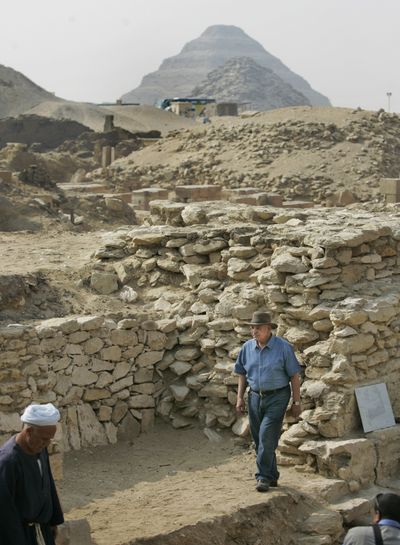Egypt announces discovery of 4,300-year-old pyramid
Tomb believed to belong to queen

SAQQARA, Egypt – Archaeologists have discovered a new pyramid under the sands of Saqqara, an ancient burial site that has yielded a string of unearthed pyramids in recent years but remains largely unexplored.
The 4,300-year-old monument most likely belonged to the queen mother of the founder of Egypt’s 6th Dynasty, and was built several hundred years after the famed Great Pyramids of Giza, antiquities chief Zahi Hawass told reporters in announcing the find Tuesday.
The discovery is part of the sprawling necropolis and burial site of the rulers of ancient Memphis, the capital of Egypt’s Old Kingdom, about 12 miles south of Giza.
All that remains of the pyramid is a 16-foot-tall structure that had been buried under 65 feet of sand.
“There was so much sand dumped here that no one had any idea there was something buried underneath,” Hawass said.
Hawass’ team had been excavating at the location for two years, but only determined two months ago that the structure, with sides about 72 feet long, was the base of a pyramid. The pyramid is the 118th discovered so far in Egypt, and the 12th to be found in Saqqara. Most are in ruins; only about a dozen pyramids remain intact across the country.
Archaeologists also found parts of the pyramid’s white limestone casing – believed to have once covered the entire structure – which enabled them to calculate that the complete pyramid was once 45 feet high.
“To find a new pyramid is always exciting,” Hawass said. “And this one is magical. It belonged to a queen.”
Hawass said he believes the pyramid belonged to Queen Sesheshet, who is thought to have played a significant role in establishing the 6th Dynasty and uniting two branches of the feuding royal family. Her son, Teti, ruled for about a dozen years until his likely assassination, in a sign of the turbulent times.
The pyramids of Teti’s two wives, discovered 100 years ago and in 1994 respectively, lie next to it, part of a burial complex alongside the collapsed pyramid of Teti himself.
The Egyptian team is still digging and is two weeks from entering the burial chamber inside the pyramid, where Hawass hopes they will find proof of its owner – a sarcophagus or at least an inscription of the queen, he said.
Finding more than that is unlikely, as robbers in antiquity looted the pyramid, he said, pointing to a gaping shaft on the structure’s top, a testament of the plunder.
Joe Wegner, an associate professor of Egyptian archaeology at the University of Pennsylvania who has been involved in other expeditions at Saqqara, cautioned that until “inscriptional confirmation is found, it’s still an educated guess” that the pyramid is Sesheshet’s.
Although evidence of the queen’s existence was found elsewhere in Egypt in inscriptions and a papyrus document, the site of her burial was not known.